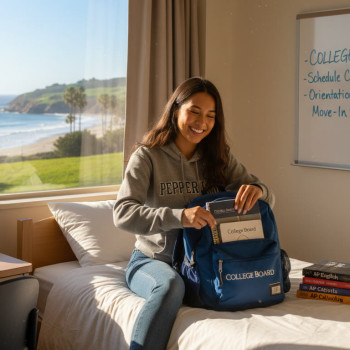AP ↔ IB DP Master Map: Group 1–6 to AP Subjects
Choosing courses in high school can feel like plotting a complex travel route across two different countries. AP (Advanced Placement) and the IB Diploma Programme (IB DP) are two academic landscapes students often navigate — and each has its own language, checkpoints, and rewards. This blog is a map and a companion: a clear, human, and practical guide to how IB DP Groups 1–6 align with AP subjects, with examples of course pairings, study strategies, and a few realistic pathways to maximize learning and college credit. Along the way I’ll show where targeted help — like Sparkl’s personalized tutoring — can make the difference between “I’ll try” and “I’ll excel.”
Why this map matters
College admissions officers and colleges look at rigor and mastery. AP exams signal subject-specific depth in a single course; the IB DP signals a broader, balanced curriculum with research, theory, and international perspective. Students often take APs within an IB school, or pick one path over the other. Understanding how IB Groups 1–6 map to AP subjects helps students and parents design schedules that are coherent, balanced, and efficient when it comes to college credit.
Quick orientation: The IB DP Groups and AP structure
Before mapping, let’s set a common language.
- IB DP Groups 1–6 are: Group 1 — Studies in Language and Literature; Group 2 — Language Acquisition; Group 3 — Individuals and Societies; Group 4 — Sciences; Group 5 — Mathematics; Group 6 — The Arts (or an elective).
- AP organizes subjects as standalone courses (AP Calculus, AP Biology, AP English Literature, AP US History, AP Psychology, etc.). Students usually pick AP classes by interest and college goals rather than by a formal grouped program.
Mapping is not always a one-to-one translation. Instead, think of it as a best-fit comparison: matching the IB content, skills, and assessment styles with their AP counterparts.
Master Map: IB DP Groups 1–6 and their closest AP equivalents
The table below shows commonly accepted alignments — useful for scheduling, credit planning, or crosswalking coursework on a transcript.
| IB DP Group | Typical IB Courses | Closest AP Subjects | Notes on Alignment |
|---|---|---|---|
| Group 1 — Language & Literature | Language A: Literature, Language A: Language and Literature | AP English Literature and Composition, AP English Language and Composition | IB focuses on textual analysis and global literary contexts; APs target close reading and rhetoric. Either AP or IB offers rigorous writing practice. |
| Group 2 — Language Acquisition | Language B or ab initio (e.g., Spanish B, French B) | AP Spanish Language and Culture, AP French Language and Culture, AP German | AP language exams assess proficiency and cultural competence similar to IB B-level courses; ab initio may not map directly to AP without extra years of study. |
| Group 3 — Individuals & Societies | History (regional), Economics, Global Politics, Psychology, Geography | AP World History, AP US History, AP European History, AP Economics (Micro/Macro), AP Psychology, AP Human Geography | Content coverage overlaps widely; IB’s internal assessments and TOK linkages add skills beyond AP’s exam focus. |
| Group 4 — Sciences | Biology, Chemistry, Physics, Environmental Systems | AP Biology, AP Chemistry, AP Physics (1/2/C), AP Environmental Science | IB lab work and internal assessments emphasize experimental design alongside theory. AP offers rigorous content exams and labs; AP Physics C is calculus-based similar to IB Physics HL with math. |
| Group 5 — Mathematics | Mathematics: Analysis and Approaches, Mathematics: Applications and Interpretation | AP Calculus AB, AP Calculus BC, AP Statistics | Math: Analysis aligns more with AP Calculus BC; Applications often aligns with statistics or applied math — both IB and AP have different emphases on proof, modeling, and technology. |
| Group 6 — The Arts / Elective | Visual Arts, Music, Theatre, or another Group 3/4/5 subject | AP Art and Design (2D/3D/Drawing), AP Music Theory, AP Studio Art equivalents | IB arts include portfolios and exhibition; AP portfolios and written components have overlapping assessment styles for college credit consideration. |
How to read the map
Use this map to solve practical questions: Which AP should I take if I’m in IB History? Can I take AP Calculus while taking IB Math SL? The short answer: yes, often — but it depends on timing, workload, and your goals. Below are typical pairings, with examples and suggested approaches.
Practical pairings and sample schedules
Here are realistic, student-friendly class plans across three common scenarios: a college-credit-maximizer, a balanced IB+AP student, and a content-depth specialist.
1) College-credit-maximizer (AP-heavy with IB components)
- Junior year: AP Calculus AB or BC, AP Chemistry, AP English Language, IB Language B (if continuing a second language)
- Senior year: AP Biology or AP Physics 1/2 (depending on interest), AP English Literature, AP Government or AP Economics, complete IB DP project if applicable
Why this works: AP exams give targeted content that many colleges grant credit for. If you’re not pursuing full IB DP but want IB’s strengths (e.g., global perspective), keep at least one IB course — especially in language or individuals and societies — to demonstrate breadth.
2) Balanced IB+AP student (mixing HL/SL IB with AP)
- Junior year: IB English A HL, IB History SL + AP US History (if the school allows concurrent AP), IB Math HL or SL alongside AP Calculus AB
- Senior year: IB Biology HL with AP Biology exam, IB Language B SL, and AP Psychology or AP Economics as an elective
Why this works: Keep your IB HL choices where you want deep exploration and use APs to supplement areas where IB SL might not cover the specifics of an AP exam. Colleges see the HL rigor and AP exam scores as complementary evidence of subject mastery.
3) Content-depth specialist (STEM or Humanities)
- STEM-focused: IB Physics HL + AP Physics C, IB Math HL + AP Calculus BC, AP Chemistry or IB Chemistry HL
- Humanities-focused: IB History HL + AP European/US History, IB Language A HL + AP English Literature, AP Psychology + IB Global Politics
Why this works: If you’re targeting a specific major, deepen in those subjects using both systems where possible. For instance, AP Physics C’s calculus emphasis mirrors IB Physics HL calculus demands — a strong combination for engineering applicants.
Assessment styles: how IB and AP test what you know
Understanding assessment differences helps you study smart, not just hard.
- AP exams are mostly end-of-course standardized exams focused on knowledge, application, and problem solving. Many are multiple-choice plus free response (essays, problems, portfolios for art).
- IB DP combines external exams with internal assessments: oral presentations, lab reports, essays, and the Extended Essay (EE). This mix values process, research, and application across contexts.
Study implication: For APs, practice timed exams and targeted content review. For IB, build long-term project habits, manage internal assessment deadlines early, and practice sustained writing (EE) and oral skills.
Study strategies that work across both systems
Here are techniques that pay dividends whether you sit for AP exams, IB finals, or both.
- Backward planning: Start from exam dates and work backwards. Break content into monthly milestones for knowledge and weekly micro-goals for practice.
- Active retrieval: Regular low-stakes quizzing beats re-reading. Use flashcards, practice problem sets, and past papers.
- Integrated notes: If one topic appears in both IB and AP, keep a single master note set cross-referenced to both syllabuses.
- Skill layering: Build essay structure first, then layer content; practice labs by writing methods and results before doing the experiment.
- Work on timing: AP free-response and IB exam papers require pacing — simulate timed conditions periodically.
Example: preparing for both IB Biology HL and AP Biology
Combine the approaches: use the IB syllabus to plan long-term IA experiments, and schedule AP-style practice exams to sharpen recall and MCQ technique. Sparkl’s personalized tutoring can provide 1-on-1 guidance for creating a tailored study plan and targeted feedback on lab write-ups and timed practice.

How colleges view combined AP and IB coursework
Admissions officers value intellectual curiosity and demonstrated mastery. Combining AP and IB can show both depth and breadth: APs demonstrate mastery in discrete subjects; IB HLs signal sustained academic intensity and interdisciplinary skills. When planning, keep these priorities in mind:
- Quality beats quantity: strong performance in a few rigorous courses matters more than weak performance across many.
- Show coherence: link coursework to intended major where possible.
- Highlight unique skills: Extended Essay, TOK (Theory of Knowledge), lab IAs, and AP research/portfolios — these show research, reflection, and independence.
Credit and placement considerations (general guidance)
Credit policies vary by college. AP scores of 4–5 often earn credit; some colleges accept 3s. IB HL exam scores and full DP completion can also lead to credit or advanced placement. Because policies are specific to each institution, use the following approach:
- Target high AP scores (4–5) for predictable credit.
- If pursuing IB DP, aim to demonstrate depth in HL subjects that align with future major requirements.
- Keep syllabi and portfolios organized to make credit appeals easier after admission.
Common student scenarios and recommended roadmaps
Below are short, actionable roadmaps for common student profiles.
The Overloaded Perfectionist
Problem: Taking too many HLs plus multiple APs, burning out before senior year.
Solution: Prioritize two HLs aligned with your intended major; pick 1–2 APs that provide college credit or strengthen perceived depth. Build recovery time in your schedule and use targeted tutoring to increase efficiency rather than hours. Sparkl’s tailored study plans help redistribute effort to where it matters most.
The College Credit Seeker
Problem: Wants to maximize AP credits to skip introductory courses in college.
Solution: Focus on AP Calculus BC, AP Physics C (for engineering), AP Chemistry, AP Biology, and AP Language/Literature as appropriate. Consider taking IB courses that align to deepen understanding but keep your AP exam schedule the priority.
The Well-Rounded Applicant
Problem: Want breadth — languages, sciences, arts — without sacrificing depth.
Solution: Pursue IB DP with a mix of HL and SL courses, and pick 1–2 APs in areas you love or where credit is likely. Use IB’s Extended Essay to tie your interests into a unique narrative for college essays.
Tips for parents: how to support without micromanaging
- Help students build a master calendar of exams, IA deadlines, and college application tasks.
- Encourage balanced sleep, regular meals, and short exercise breaks — these are productivity multipliers.
- Consider targeted external support (like Sparkl’s 1-on-1 tutoring) when a student needs subject-specific expertise or help constructing a long-term study plan.
- Ask questions about learning (not just grades): What did you find interesting? What was most challenging? This promotes reflection and resilience.
Study resources and practice strategies (practical checklist)
- Collect official syllabi for both IB and AP subjects you’re taking and cross-reference learning outcomes.
- Create a weekly study block for practice exams — alternate AP-style timed MCQs and IB-style extended responses.
- Build an IA/EE timeline in September of the year you start the project; chunk work into manageable weekly goals.
- Use past papers: practice under test conditions once every 2–3 weeks and review errors deeply.
- Set measurable goals (e.g., “Increase AP Calculus free-response score from 6/9 to 8/9 in 8 weeks”) and track progress.
Closing thoughts: Your personal curriculum map
Whether you’re leaning toward APs, IB DP, or a tailored mix, remember the core question: what do you want to be able to do by the end of the year? APs sharpen exam technique and subject knowledge. IB DP builds research, reflection, and global perspective. Together, they can create a powerful academic profile — if chosen deliberately.
Practical next steps: draft a three-year plan (sophomore through senior year), mark AP test dates and IB internal assessment deadlines, and schedule regular review checkpoints. If your student could use one-on-one guidance in designing that plan or staying on track with draft feedback, Sparkl’s personalized tutoring offers tailored study plans, expert tutors, and AI-driven insights to keep progress measurable and sustainable.

Final checklist: mapping success
- Consult syllabi and college credit policies early.
- Choose HLs and APs that align with your future major and interests.
- Balance depth with well-being — fewer, stronger courses beats surface-level overload.
- Practice both timed exams and long-form research/writing.
- Get targeted help when needed: a tutor for a tricky HL concept, feedback on an IA, or timed-exam strategies — personalized support accelerates progress.
One last note
Academic maps are living documents: adapt them as interests evolve. The best plan is one that reflects who you are, what you love, and how you learn. With careful mapping, steady work, and the right support system — including focused tutoring when needed — students can turn the complexity of APs and IB DP into a coherent story that opens doors to college and beyond.
Good luck plotting your path — and remember, the journey is as important as the destination.


















No Comments
Leave a comment Cancel